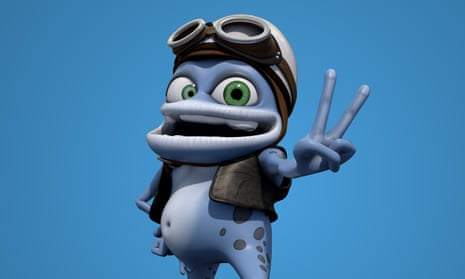For a few months in 2005, you couldn’t move without encountering Crazy Frog. First sold as a ringtone, his nonsensical catchphrase, “Rring ding ding ding baa baa”, entered the national vocabulary. Then it became the most popular – and divisive – single of 2005, coupled with a CGI video of an explicitly naked frog on the lam in a futuristic cityscape. “The frog is irritating to the point of distraction and back again,” wrote BBC News. “And yet at the same, it’s strangely compelling.”
The craze lasted for five Top 20 hits and then mercifully dwindled. The character was so hated that hackers found success with a virus offering to show users an image of him being killed off. But now the frog is staging a comeback. Next month, the once-ubiquitous amphibian will release a new single – a mash-up of a classic and a more recent song, the details of which the frog’s guardians are keeping under wraps, other than to say that both are popular on TikTok.
“He looks the same, he acts the same, but he’s a fresher frog,” says Sigfrid Söderberg, CEO of Kaktus Film and Crazy Frog Entertainment. Although the character’s gibbered cry was invented by a teenager called Daniel Malmedahl in 1997 and his body created by animator Erik Wernquist in 2003, Crazy Frog Entertainment owns the intellectual property, and Söderberg and his business partner Andreas Wicklund produce the character’s videos. The frog’s future is in Söderberg’s hands.
You might well question who wants this dated irritation back, but the frog fandom endures. The original hit has more than 3bn views on YouTube, making it the 26th most-watched video on the site, and the Crazy Frog YouTube channel has 11.5m subscribers. Interest seemed to surge a few years ago, says Söderberg, who claims that it was at one point getting 4m new views per day. Earlier this year, Rita Ora sampled the Axel F track in her song Bang Bang (though this is news to Söderberg). Kaktus decided that the world was telling it one thing: bring back the frog.
There were two important steps in Crazy Frog’s original ascent to cultural infamy. The first came when the mobile phone content provider Jamba! called Wernquist, who had landed a job at Kaktus thanks to his frog design, to ask if they could license the character’s noise for a ringtone. In 2004, ringtones were a billion-dollar industry with their own charts – even printed in the pages of NME, to the horror of some loyal readers. Kaktus agreed an advance and a royalties arrangement (“obviously way too low”, says Söderberg) and the deal was done. Jamba! then spent an unprecedented amount of money promoting the infectious ringtone on TV – in May 2005, it was shown 2,378 times a day – incurring the wrath of the British public. “I myself got annoyed with it,” admits Söderberg. “It was too much.”
The worst was yet to come. Wolfgang Boss, executive president of A&R at Sony Music, wanted to pair the frog with a sped-up version of the theme tune to Beverly Hills Cop, a song called Axel F. Kaktus agreed to make the animation on condition that they had carte blanche to do what they wanted. In the video, a bounty is placed on the frog’s head and a sinister character chases him around the city, eventually firing a rocket at him – which the frog ends up riding to safety. When the song came out in May 2005, it changed the lives of everyone involved. “The minute that was released, boom – it was No 1 in 23 countries in the world,” says Söderberg, who found himself travelling the world to collect gold and platinum records.

He also found himself facing the wrath of the Advertising Standards Authority. Crazy Frog’s penis was clearly visible in the video, which attracted mass complaints. The fuss bemused Söderberg. “It’s like seeing a baby’s penis,” he reasons. “He’s a baby in his mind and his body. He was originally created like that, as we all were.”
Sixteen years on, the public’s rage may have subsided – or, at least, the frog may benefit from a social media audience too young to remember his original incarnation. In the spring, various TikTokers with millions of followers, including Kimberly Loaiza (55.2m) and Karla Bustillos (20m), performed choreographed dances to the track. Kaktus has learned from its mistakes, Söderberg says, and now chooses business partners more carefully. “He didn’t deserve to be a ringtone figure,” says Söderberg. “We want to do it right this time: we want to have funny songs, funny TV series, funny little books; make him have the longevity we wanted last time.”
But can the frog survive this cruel new world – isn’t he a relic? “He’s actually more tuned in to this world,” says Söderberg, arguing that short, funny clips are even more popular now than they were in 2005. “Musically there will always be a place for kind of novelty songs. He’s not Stormzy; he doesn’t need to do credible, cool, urban stuff.”
How does the frog feel about the comeback? “The frog is always completely oblivious,” says Söderberg. “I would say he’s very happy as always. For him, he was never away – or there, even.”

Comments (…)
Sign in or create your Guardian account to join the discussion